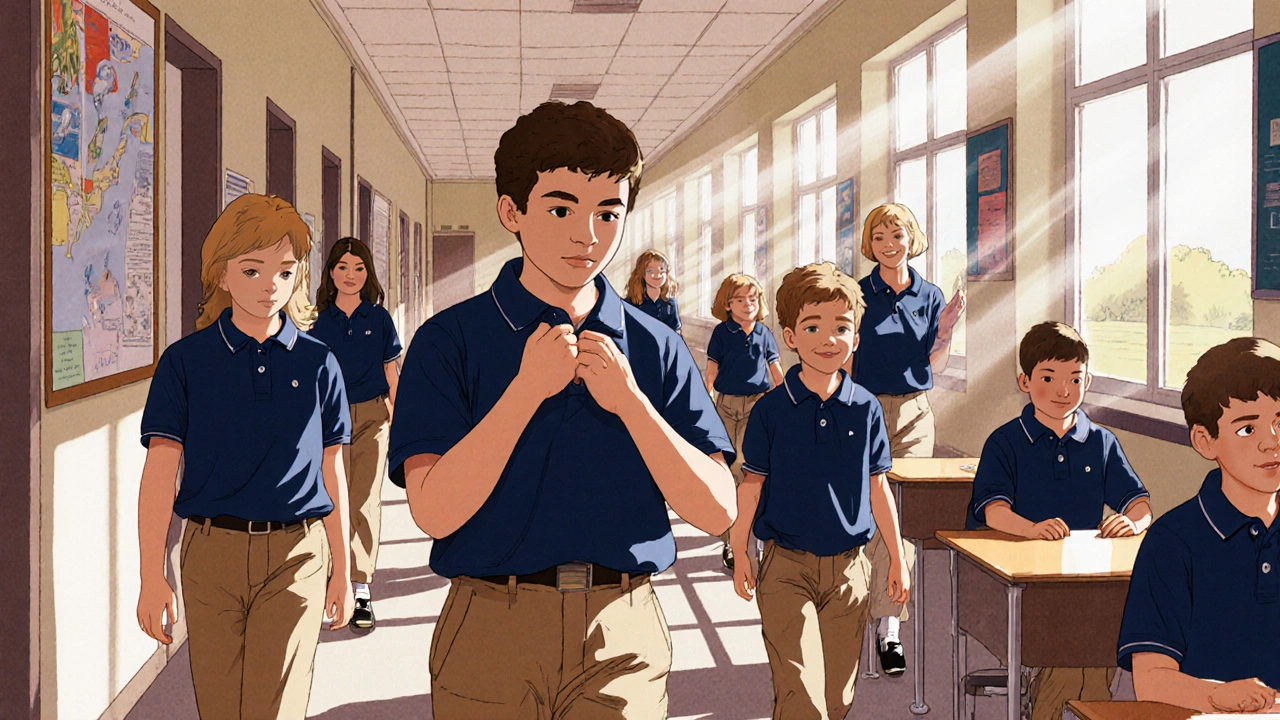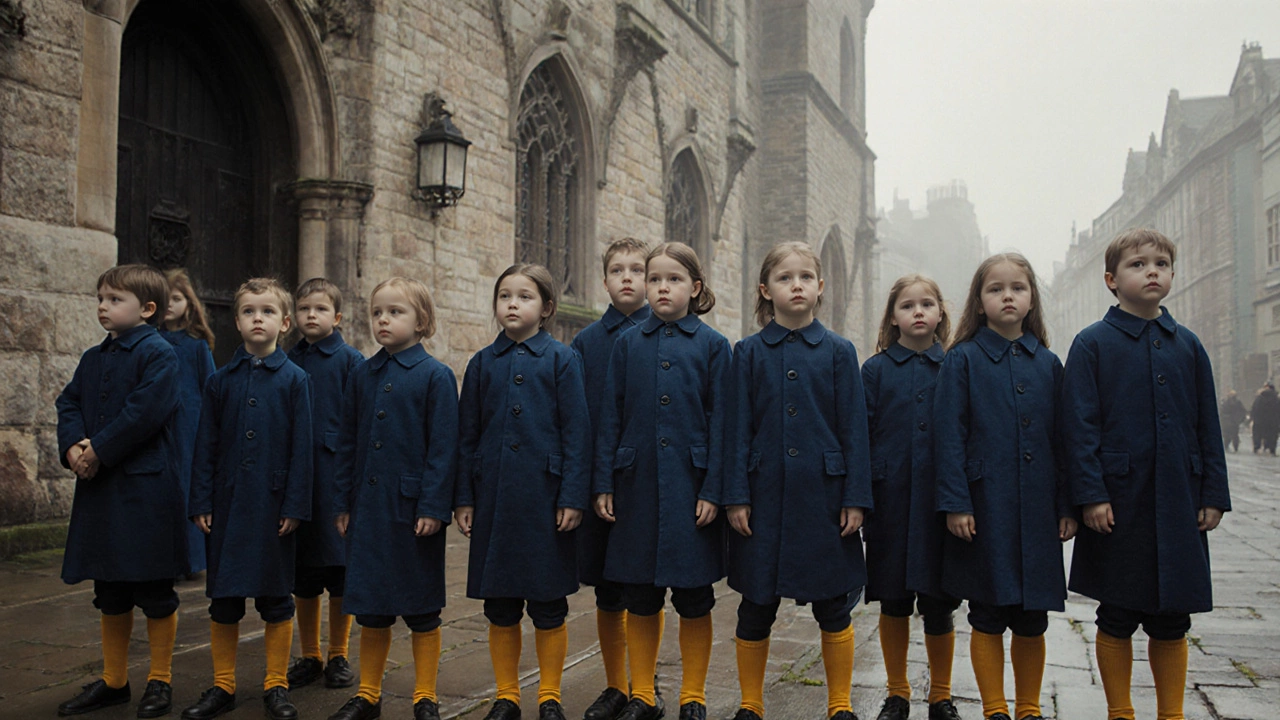School Uniform Cost Calculator
Uniform Cost Calculator
See how much money your family could save by choosing school uniforms instead of regular clothing.
Your Savings
$0.00
in potential savings over a school year
Think school uniforms have always been around? They weren’t invented by a single person or even a single country. The idea didn’t pop up in a boardroom or a government meeting. It started with school uniforms in medieval England - not to control students, but to erase class lines.
Where It All Began: Christ’s Hospital, 1552
The first known uniform for students wasn’t worn at a modern school. It was worn by orphans at Christ’s Hospital in London, founded in 1552. These kids, many of them poor or abandoned, were given identical blue coats, yellow socks, and knee breeches. The outfit wasn’t about discipline. It was about dignity. The school wanted them to look like they belonged - not like beggars.
The blue coat became so iconic, it’s still worn today by students at Christ’s Hospital. That’s over 470 years of the same design. No other school uniform has lasted this long. And it wasn’t copied because it looked good. It was copied because it worked. It made kids from different backgrounds look the same - and that mattered.
Why Uniforms Spread: Class, Control, and Religion
By the 1700s, elite private schools like Eton and Harrow started adopting similar styles. Their uniforms weren’t blue coats. They were tailored jackets, waistcoats, and top hats - symbols of status, not equality. But here’s the twist: even though these were clothes of the upper class, they were still uniforms. The point? To create a shared identity among boys who would one day rule Britain.
Religious schools followed. In Catholic and Protestant institutions across Europe, uniforms were used to suppress individuality. Hair length, jewelry, and even the color of your shoes were regulated. The message was clear: your identity as a student came before your identity as a person. This wasn’t just fashion. It was social engineering.
The American Shift: From Freedom to Formality
In the U.S., public schools didn’t use uniforms for centuries. Kids wore what they had - patched pants, hand-me-down dresses, work boots. That changed in the late 1980s and early 1990s. Crime rates were rising. Schools in cities like Baltimore and Los Angeles began experimenting with uniforms to reduce violence and bullying.
One study from the U.S. Department of Education in 1998 found that schools with uniforms saw a 16% drop in disciplinary incidents. It wasn’t magic. It was simple: when everyone looks the same, it’s harder to target someone for their clothes. A kid in a $200 sneaker isn’t a target if everyone’s wearing the same pair of black shoes.
By 2020, about 20% of U.S. public schools required uniforms. That number jumped to 27% by 2024, especially in urban districts. The biggest drivers? Parents worried about bullying, principals tired of dress code fights, and district budgets that saw uniforms as a way to cut costs on clothing.

Modern Uniforms: More Than Just Pants and Shirts
Today’s school uniforms aren’t just navy blazers and pleated skirts. They’ve evolved. Many schools now allow polo shirts, khaki pants, and even leggings. Some let kids wear hoodies if they’re part of the approved uniform line. Others use color-coded uniforms by grade - first graders wear red, fifth graders wear green.
Why the change? Flexibility. Parents don’t want to buy five identical outfits. Schools don’t want to punish kids for a missing button. The goal shifted from control to inclusion. Uniforms now often come with options: short sleeves or long sleeves, skirts or pants, sneakers or loafers. The look is standardized, but the comfort isn’t sacrificed.
Brands like Lands’ End, Hanna Andersson, and J.C. Penney now have entire school uniform sections. In 2023, the U.S. school uniform market hit $12 billion. That’s not just about tradition. It’s about convenience. Parents buy online, in bulk, with free returns. Schools partner with retailers to offer discounts. Uniforms became a product - not a policy.
Global Differences: What Uniforms Look Like Around the World
Japan’s school uniforms are famous - sailor outfits for girls, gakuran jackets for boys. They’ve been standard since the 1870s, when Japan modernized its education system after opening to the West. The designs were borrowed from military uniforms to show discipline and order.
In the UK, uniforms are still strict. Many schools require ties, blazers, and specific socks. Some even dictate the brand of shoes. In contrast, countries like Germany and Finland rarely use uniforms. Their philosophy? Education should focus on learning, not appearance.
And in parts of Africa and Latin America, uniforms are often the only clothing many kids own. In rural Kenya, a school uniform might be the only clean, matching outfit a child has all week. It’s not about conformity. It’s about access.

Are Uniforms Still Relevant Today?
Some say uniforms kill self-expression. Others say they level the playing field. The truth? It depends on how they’re used.
At schools where uniforms are enforced with punishment - detention for wrong socks, phone calls home for untucked shirts - they breed resentment. But at schools where uniforms are part of a bigger culture of respect and community, they work. One principal in Chicago told me, “We don’t care if your shirt is wrinkled. We care if you show up ready to learn.” That’s the difference.
And let’s not ignore the economic side. A single uniform outfit costs $50-$100. That’s far less than buying 20 different outfits for a school year. For low-income families, uniforms can mean less stress, fewer arguments, and more money for food or books.
The Future of School Uniforms
What’s next? Sustainability. More schools are switching to recycled polyester and organic cotton. Some are letting students design their own uniforms through contests. Others are using QR codes on tags so parents can track sizing and replacements.
One school in Oregon started a uniform swap program. Kids bring in gently used uniforms, trade them, and get new ones for free. No one pays. No one feels ashamed. It’s practical. It’s kind. And it’s the future.
So who created school uniforms? No one person. It was a slow, messy, global evolution - shaped by poverty, power, religion, and practicality. They weren’t invented to look nice. They were invented to make life simpler - for kids, for parents, for schools.
And maybe that’s why they still exist today.
Who invented the first school uniform?
The first known school uniform was created for students at Christ’s Hospital in London in 1552. The uniform - a blue coat, yellow socks, and knee breeches - was designed to give orphans a sense of belonging and to hide differences in wealth. It’s still worn today, making it the oldest continuous uniform in the world.
Why did schools start requiring uniforms?
Schools started requiring uniforms for several reasons: to reduce visible class differences, to promote discipline, and to make students feel part of a group. In the 1990s, U.S. schools added uniforms to cut down on bullying and violence tied to clothing choices. Today, many schools use them to simplify daily routines and reduce pressure on families to keep up with fashion trends.
Are school uniforms mandatory in the U.S.?
No, school uniforms are not mandatory nationwide. But about 27% of U.S. public schools required them in 2024, mostly in urban areas and charter schools. Rules vary by district - some require full uniforms, others only allow specific colors or styles. Private schools are far more likely to enforce uniforms than public ones.
Do uniforms improve academic performance?
There’s no strong evidence that uniforms directly boost test scores. But studies show they can reduce distractions, lower bullying, and improve attendance. When students aren’t focused on what others are wearing, they’re more likely to focus on learning. The biggest academic benefit comes from the culture uniforms help build - one of order, respect, and shared purpose.
What’s the difference between uniforms and dress codes?
A uniform means everyone wears the exact same outfit - same shirt, same pants, same shoes. A dress code is looser: it sets rules like “no tank tops” or “no shorts above the knee,” but lets students choose their own clothes within those limits. Uniforms are stricter and more uniform (literally). Dress codes give more freedom but can lead to more enforcement issues.
How much do school uniforms cost?
A full set of school uniforms typically costs between $50 and $150, depending on quality and brand. That’s far less than buying 15-20 different outfits for the school year. Many schools partner with retailers to offer discounts, and some run uniform exchange programs where families can trade gently used items for free.
